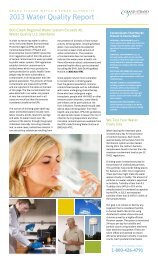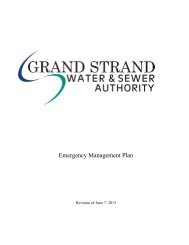2030 Plan - Grand Strand Water and Sewer Authority
2030 Plan - Grand Strand Water and Sewer Authority
2030 Plan - Grand Strand Water and Sewer Authority
You also want an ePaper? Increase the reach of your titles
YUMPU automatically turns print PDFs into web optimized ePapers that Google loves.
(1) Socastee Sod Farm<br />
The Socastee Sod Farm was the first sod farm developed by GSWSA. It was developed<br />
<strong>and</strong> exp<strong>and</strong>ed concurrently with the Schwartz WWTP to h<strong>and</strong>le the biosolids from the<br />
plant <strong>and</strong> use part of the plant effluent for irrigation needs. The 415 acre site has 210<br />
acres permitted <strong>and</strong> used for disposal of treated biosolids <strong>and</strong> effluent to aid in the<br />
production of 419 Bermuda sod. About 50 acres may be developed for future biosolids<br />
disposal <strong>and</strong> the remainder is buffer, storage lagoons, <strong>and</strong> wetl<strong>and</strong>s. The farm operates<br />
three storage lagoons, an 8 MG aerated lagoon for temporary storage of excess Schwartz<br />
plant influent or effluent, a 10 MG lagoon for storm water, <strong>and</strong> a 6 MG lagoon for storm<br />
water or effluent. The farm also operates 0.6 MG of aerated biosolids storage tanks.<br />
GSWSA sold 654,642 square feet of Bermuda sod last year.<br />
(2) Bucksport Sod Farm<br />
The Bucksport Sod Farm was developed concurrently with the Bull Creek Surface <strong>Water</strong><br />
Treatment <strong>Plan</strong>t to dispose alum sludge <strong>and</strong> backwash water. Subsequently it has been<br />
permitted for disposal of Myrtle Beach water plant alum sludge <strong>and</strong> treated wastewater<br />
biosolids from several of GSWSA’s smaller treatment plants. The 490 acre site has 341<br />
acres permitted for alum sludge <strong>and</strong> 175 acres of that is permitted for wastewater<br />
biosolids to aid in the production of centipede sod. About 50 acres may be developed for<br />
sludge reuse in the future <strong>and</strong> the remainder is buffer <strong>and</strong> wetl<strong>and</strong>s.<br />
GSWSA sold 1,463,496 square feet of centipede sod last year.<br />
(3) Tip Top Tree Farm<br />
This 4,464 acre site is about half wetl<strong>and</strong>s <strong>and</strong> half upl<strong>and</strong>s. DHEC has permitted 1,600<br />
acres of s<strong>and</strong>y upl<strong>and</strong> soils as acceptable for tree farm irrigation with 10.5 MGD of<br />
treated effluent from the Schwartz <strong>and</strong> Bucksport WWTPs. Currently 700 acres are used<br />
to dispose of up to 5 MGD of effluent from these facilities to aid in the production of<br />
hardwood trees. The site has several colonies of Red Cockaded Woodpeckers <strong>and</strong> 300<br />
acres are set aside as Safe Harbor areas for the protection <strong>and</strong> propagation of this<br />
endangered species. Approximately 800 additional acres are used for biosolids reuse.<br />
(4) Yauhannah Tract<br />
This 3,226 acre site has approximately 1,200 acres of upl<strong>and</strong>s tree farm with the<br />
remainder being riverine <strong>and</strong> isolated wetl<strong>and</strong>s. The site was purchased in 2004 <strong>and</strong> is<br />
permitted used for bio-solids application to enhance tree growth.<br />
(5) Carolina Bays<br />
This 700 acre site at the Vereen WWTP consists of four Carolina Bays ranging in size<br />
from 130 to 250 acres. These Bays were originally permitted by EPA <strong>and</strong> DHEC as an<br />
54






